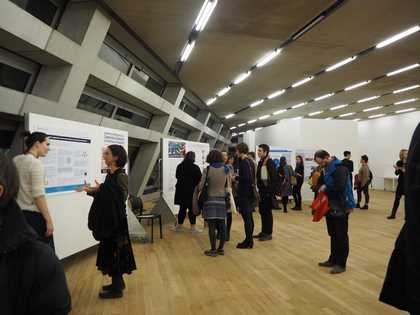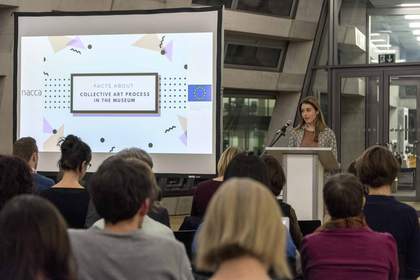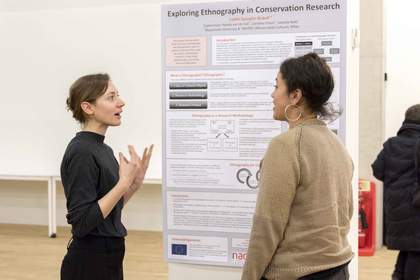On 16-20 January 2017, Tate hosted ‘Professional Skills for the Museum and Heritage Sector’, a week-long training event for fifteen doctoral students from the research and training network New Approaches in the Conservation of Contemporary Art (NACCA).
The winter school’s programme generated discussion and reflection around the practices of collaboration and communication within the museum, addressing issues such as: changing practices in museums, object-based scholarship, writing about art, researcher-practitioner collaboration, interdisciplinary collaboration and communication, research dissemination, and exhibiting conservation.
The programme opened with a public event in Tate Exchange, where the researchers presented their research to an audience of more than a hundred people. Each of the doctoral students described an aspect of their project, then participated in a poster session where they discussed their work with members of the public.

NACCA Winter School 2, Tate, 16-20 January 2017
The rest of the week’s activities comprised a series of lectures, seminars, and panel discussions. Tate staff Rachel Barker, Bronwyn Ormsby, Matthew Gale and Maria Kennedy reflected on the restoration of Mark Rothko Black on Maroon 1958. Jill Sterrett, director of collections at SFMOMA, led an open discussion reflecting on collections and keepers, and the evolving role of the museum in the 21st century. Bartolomeo Pietromarchi, director of MAXXI Arte in Rome, presented a session considering the action artworks of the 1960s and 1970s, and strategies for keeping these works present while avoiding creating ‘half-living, half-dead’ versions. Sanneke Stigter and Ella Hendriks, from the University of Amsterdam’s Conservation and Restoration of Cultural Heritage programme, led an interactive session where students developed strategies for exhibiting conservation.
The Head of Collection Research at Tate, Jennifer Mundy, led an interactive session which considered different approaches to object-based scholarship, the ‘biography’ of an artwork, and the role of objectivity and subjectivity in research. Christopher Griffin, Susannah Worth and Chloe Julius, from Tate’s Research Department, ran highly participatory workshops focused on writing and editing, building a research profile and optimising the impact of research.

Sophie Lei, PhD student, NACCA Winter School 2
Tate’s Head of Collection Care Research, Pip Laurenson and Haidy Geismar, Reader in Anthropology at UCL, spoke about their own experiences of interdisciplinary collaborative research. This session focused on the ethics of collaboration, the importance of a commitment to multiple outcomes, and the benefits of recognising the multiple audiences of research. Led by Julia Noordegraf, Professor of Digital Heritage at the University of Amsterdam, NACCA researchers considered the role of research networks within their own projects. Conservator and Professor in Museum Studies at NYU, Glenn Wharton attended the training in his capacity as advisor to the NACCA researchers, and also presented on his current project: a reader for contemporary art conservation.

Research posters exhibition, NACCA Winter School 2
A highlight of the week centred around Tony Conrad’s audio-visual work Fifty Five Years on the Infinite Plain 1972-2017. The NACCA researchers attended a performance of this compelling work in the Tanks, and later participated in a round table discussion with curator Andrea Lissoni, and several members of Tate’s time-based media conservation team. Together they debated strategies for acquisition, installation, performance, and long-term care that take into account the evolving ontology of the work.
